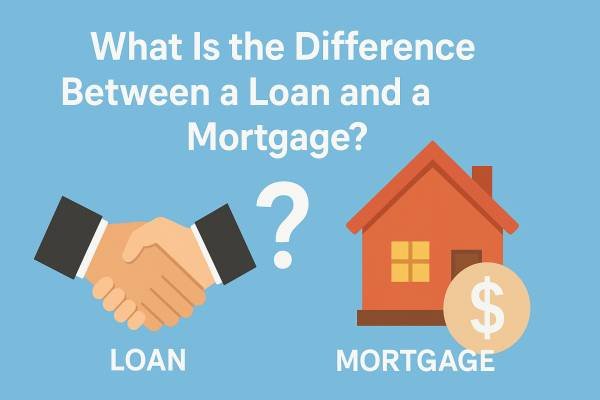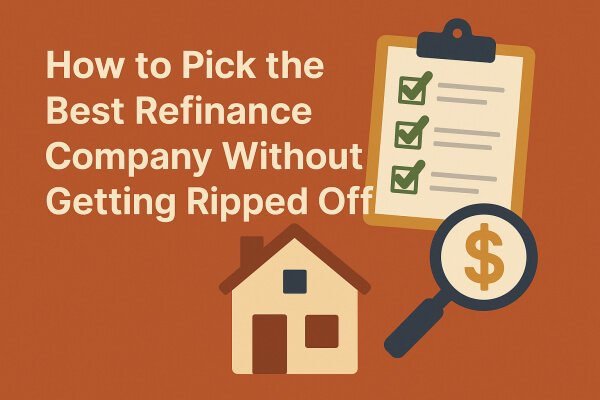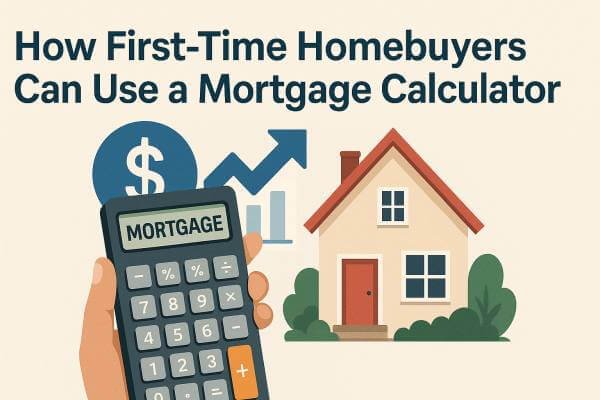What Is the Difference Between a Loan and a Mortgage?

Ever wonder what the real difference is between a loan and a mortgage? You are definitely not alone. These two terms come up a lot, especially when you start thinking about borrowing money. But while a loan and a mortgage might sound like the same thing, they actually work very differently.
In simple terms, a loan is any amount of money you borrow that you agree to pay back over time with interest. A mortgage is a special kind of loan that is only used to buy or refinance a home. So while every mortgage is a loan, not every loan is a mortgage.
In this guide, we will walk through the key differences between the two. We’ll examine their functions, uses, costs, and qualification requirements. Whether you are getting ready to buy your first home or just want to understand your options, this post will help you make smart financial decisions with confidence.
Key Characteristics of a Loan and a Mortgage
Understanding the basics of how loans and mortgages work is the first step to making a smart borrowing decision. While they both involve borrowing money, the structure, purpose, and terms are quite different.
1. Purpose and Use
A loan is versatile. You can use it for almost anything, including medical bills, car repairs, vacations, or debt consolidation. A mortgage, however, is specifically used for buying or refinancing real estate. You cannot use mortgage funds for personal expenses or other purchases.
2. Secured vs Unsecured
Most personal loans are unsecured. This means you do not need to put up any property or assets to qualify. That makes them more accessible but also riskier for the lender, which is why interest rates are usually higher.
The home you are buying always secures the mortgage. If you stop making payments, the lender has the legal right to take back the property through a process called foreclosure.
3. Repayment Terms
Loans usually have shorter repayment periods. Most personal loans are repaid over a period of one to seven years. Mortgages are long-term and commonly spread out over fifteen to thirty years. This option gives you smaller monthly payments, but you will pay more interest over time.
4. Loan Amounts
These amounts are typically smaller since they are unsecured. Most lenders cap personal loans around fifty thousand dollars, though this can vary. Mortgages allow you to borrow much more, often in the hundreds of thousands, since the property acts as security for the lender.
Comparing Interest Rates and Fees
When looking at a loan and a mortgage, one of the most important things to compare is how much each will cost you over time. This includes interest rates, fees, and other expenses that can accumulate quickly if you are not careful.
Who Gets the Better Interest Rate
In most cases, mortgages have lower interest rates than personal loans. Your home secures mortgages, thereby lowering the lender’s risk. With personal loans, especially unsecured ones, there is no asset backing the loan, so the lender charges more to cover that extra risk.
What APR Really Means
APR stands for annual percentage rate. It includes the interest rate plus any additional fees, giving you a more complete picture of the total cost. Whether you are comparing a loan or a mortgage, always look at the APR instead of just the interest rate. It helps you see which option is truly cheaper over time.
Extra Costs You Should Know About
Personal loans sometimes come with an origination fee, which is usually a small percentage of the total loan amount. This fee is often taken out before you receive your funds.
Mortgages come with a list of closing costs. These can include appraisal fees, title search fees, lender charges, and more. Closing costs can range from two to five percent of the home’s purchase price, so they are a major factor to consider.
Down Payment Requirements
Most personal loans do not require a down payment. You borrow the entire amount and begin repaying it with interest immediately.
Mortgages are different. You usually need to make a down payment, which is a portion of the home’s price that you pay upfront. Depending on the loan program and your credit, this could be anywhere from three percent to twenty percent or more.
Types of Loans vs Types of Mortgages
There is no universal approach to borrowing money. Different types of loans and mortgages exist for different needs, and knowing the options can help you make the right choice.
Common Types of Loans
1. Personal loans are flexible and can be used for almost anything. People often use them to cover medical expenses, emergency repairs, weddings, or to consolidate high-interest debt.
2. Auto loans are meant for buying a car. The car itself acts as collateral, which means if you stop making payments, the lender can take it back.
3. Student loans are designed for education-related costs. These can come from the federal government or private lenders. Typically, federal loans have lower interest rates and more options for repayment.
Each of these loan types serves a different purpose and comes with its terms, interest rates, and borrowing limits.
Common Types of Mortgages
1. Fixed-rate mortgages have an interest rate that stays the same for the entire term. This makes it easier to plan your budget because your monthly payment will not change.
2. Adjustable-rate mortgages start with a lower interest rate that can increase or decrease over time, depending on the market. These are better suited for people who plan to sell or refinance before the rate adjusts.
3. FHA loans are backed by the government and are a great option for first-time homebuyers or those with lower credit scores. They allow smaller down payments and have more flexible credit requirements.
4. VA loans are available to veterans, active-duty service members, and some military spouses. These loans offer benefits like no down payment and no private mortgage insurance.
5. Jumbo loans are used to buy homes that cost more than the standard loan limit. They usually require excellent credit and a larger down payment.
6. Home equity loans let you borrow money using the value you have built up in your home. It is similar to a personal loan but backed by your property. Many people use this option for large expenses like renovations, education, or debt consolidation. Just like a mortgage, if you cannot repay it, your home could be at risk.
Eligibility and Application Process for a Loan and a Mortgage
The process looks a bit different for each one, and lenders check for different things depending on what you are applying for.
1. Credit Score and History
Your credit score is one of the first things any lender will look at. For a personal loan, most lenders want to see at least a fair to excellent score, usually somewhere in the 600s or higher.
With mortgages, your score matters even more. Most mortgage lenders prefer scores above 620, although some government-backed options like FHA loans may allow lower scores. The higher your score, the better your chances at a lower interest rate.
2. Income and Employment
Lenders need to know you can repay what you borrow. That means they will ask about your income, job history, and monthly expenses. For both a loan and a mortgage, you will need to show proof of income, such as pay stubs, tax returns, or bank statements.
Mortgages typically take a more thorough approach. They want a full picture of your financial health. They will look closely at your debt-to-income ratio, which compares what you owe each month to what you earn. If too much of your income is going toward debt, that could be a red flag.
3. Required Documents
Personal loans are simpler. You usually only need to provide identification, proof of income, and maybe a few bank statements.
For a mortgage, please anticipate a more extensive list. Most lenders will ask for the following:
- W-2s or tax returns from the past two years
- Recent pay stubs
- Bank statements from the past few months
- A list of current debts and assets
- Proof of any extra income, like bonuses or rental income
This process takes longer, but it is necessary when you are borrowing a large amount of money.
4. Approval Timeline
Personal loans tend to be quick. Some lenders offer same-day approval and funding within a day or two.
Mortgages take longer because the process involves more steps like underwriting, home appraisal, and closing paperwork. From application to final approval, the timeline is usually around 30 to 45 days, depending on how quickly everything moves.
Amortization, Prepayment, and Refinancing Options
When you’re looking at a loan and a mortgage, it helps to understand how repayment works over time. This is where things like amortization, prepayment, and refinancing come in. They might sound like complicated terms, but they are actually pretty easy to grasp once you break them down.
What Is Amortization?
Amortization is just a fancy word for how your loan is paid off in chunks over time. With most personal loans and mortgages, your monthly payment stays the same, but the way it’s split between interest and principal changes. In the beginning, more of your payment goes toward interest. As time goes on, more of it goes toward the actual loan balance.
Mortgages usually follow a long amortization schedule, often 15 to 30 years. Personal loans tend to be shorter, like three to seven years.
Can You Pay Off Early?
Yes, you can. This type of repayment is called prepayment. It means paying extra toward your loan before it’s due. For example, maybe you make a second payment in the same month, or you throw in a few extra bucks every time.
Some lenders love this approach and will not charge you for paying early. Others, especially with mortgages or longer-term loans, may charge a prepayment penalty. Make sure to review the terms before signing to avoid any unexpected charges.
Paying off early can save you a lot in interest, especially on larger loans like mortgages.
What Is Refinancing?
Refinancing means replacing your current loan with a new one that has better terms. People usually refinance to get a lower interest rate, reduce their monthly payment, or change the length of their loan.
With personal loans, refinancing is simple. You apply for a new loan and use it to pay off the old one.
Mortgages take more effort to refinance. You will go through another approval process and possibly pay closing costs again. But if interest rates drop or your credit improves, refinancing can be worth it and save you thousands over time.
Pros and Cons of a Loan and a Mortgage
If you’re considering a mortgage or need money for something else, it’s good to know what you’re getting into. If you need money for something else, it helps to understand what you are committing to.
Pros of a Personal Loan
1. Flexible use: You can use a personal loan for almost anything. Pay off debt, fund a big event, or cover emergency costs.
2. Faster approval: The process is usually quick and easy. Some lenders even offer same-day decisions.
3. No collateral required: Most personal loans are unsecured, which means you do not need to risk your home or any other property.
Cons of a Personal Loan
1. Higher interest rates: Since there is no collateral, lenders charge more to cover their risk. This can mean a higher cost over time.
2. Lower borrowing limits: You can usually only borrow smaller amounts, which might not be enough for things like buying a home.
3. Shorter repayment period: The loan’s shorter repayment period may result in higher monthly payments.
Pros of a Mortgage
1. Lower interest rates: Because your home acts as security, mortgage rates tend to be lower than personal loan rates.
2. Longer terms: You can spread payments out over many years, which helps keep monthly costs down.
3. Builds equity: As you pay down the mortgage, you build ownership in your home, which can become a valuable asset.
4. Tax benefits: In some cases, you can deduct mortgage interest on your taxes. This benefit can save you money depending on your situation.
Cons of a Mortgage
1. Takes longer to get: The approval process involves a lot of paperwork, credit checks, and a property appraisal.
2. Requires a down payment: You usually need to bring some cash up front. The more you put down, the less you borrow.
3. Risk of foreclosure: If you fall behind on payments, the lender can take your home. That makes this kind of loan a serious commitment.
Common Misconceptions About Loans and Mortgages
Many people mix up the facts when it comes to borrowing money. Whether you are thinking about a personal loan or a mortgage, it is easy to fall for myths that can lead to costly mistakes. Let’s clear up some of the biggest misconceptions about a loan and a mortgage.
1: A mortgage is not a loan
This one comes up a lot. Some people think a mortgage is something completely different from a loan. The truth is, a mortgage is a type of loan. It is just a loan that is used to buy or refinance real estate. The purpose and structure differ, but it’s still borrowed money that must be repaid with interest.
2: All loans require collateral
Not true. While mortgages and some types of loans, like auto loans, do use collateral, personal loans are often unsecured. That means you do not have to offer anything as backup. Of course, unsecured loans tend to come with higher interest rates since the lender is taking on more risk.
3: You can use a personal loan to buy a house
This sounds good in theory, but most sellers beneficial lenders will not allow it. Homes are expensive, and personal loans usually have much lower limits. Plus, personal loans are not designed for long-term repayment like mortgages are. If you want to buy a home, a mortgage is really the only path that works.
4: If you have a mortgage, you own your home
Technically, the lender still has a claim on your home until the mortgage is fully paid off. You own the property, but the lender can foreclose if you stop paying. This exception applies when the mortgage has been paid in full.
5: Fixed rates are always better
Fixed rates offer stability, but that does not mean they are always the best choice. If you only plan to stay in a home for a short time, an adjustable-rate mortgage with a lower starting rate might save you money. It all depends on your situation and how long you plan to keep the loan.
Conclusion
By now, you should have a clear picture of the difference between a loan and a mortgage. Although both types of financing involve borrowing money, they serve distinctly different purposes, like debt consolidation, personal expenses, or short-term needs. A mortgage is designed specifically for buying or refinancing real estate and usually involves a longer commitment and a bigger amount.
Understanding how a loan and a mortgage work can save you time, money, and stress. It helps you make smarter financial choices, whether you are thinking about buying your first home, tackling a major expense, or just exploring your options.
If you’re still unsure, consider your goals, how much you need to borrow, and how long you want to take to repay it. Talk to a lender or use an online calculator to compare the total cost over time.
Want to learn more? Check out our other guides on how to qualify for a mortgage, tips for improving your credit score, and the pros and cons of fixed versus adjustable interest rates.
Whatever you choose, make sure it works for you and not just the lender.
Frequently Asked Questions
1. Can I use a personal loan to buy a house?
In most cases, no. A personal loan usually does not offer enough money to cover the cost of a home. Plus, many mortgage lenders will not approve a home purchase if the down payment or full amount is coming from personal loan funds. Mortgages are specifically designed for buying property and come with longer terms, lower interest rates, and proper legal structure.
2. Which has lower interest rates, a loan or a mortgage?
Mortgages almost always have lower interest rates compared to personal loans. This is because mortgages are secured by the home, which reduces the lender’s risk. Personal loans are often unsecured, so lenders charge more to protect themselves. If getting the lowest rate possible is important to you, a mortgage will usually win.
3. How long does it take to get approved?
A personal loan can be approved in a day or two. Some online lenders can even send funds on the same day you apply. A mortgage, on the other hand, takes more time. With all the paperwork, credit checks, home appraisals, and underwriting, the process can take anywhere from 30 to 45 days or more.
4. Can I refinance both a loan and a mortgage?
Yes, you can refinance either one. Refinancing a personal loan usually means applying for a new loan with better terms to pay off the old one. Refinancing a mortgage is a bit more involved, but it can lead to a lower interest rate, smaller monthly payments, or a shorter loan term. Just make sure to factor in any fees or closing costs to see if it is really worth it.
5. Do both loans and mortgages affect my credit score?
Absolutely. Whether it is a personal loan or a mortgage, your payment history will show up on your credit report. Making payments on time can help your score, while missed payments can bring it down. Also, applying for any new credit may cause a small temporary dip in your score, but that is totally normal.
























